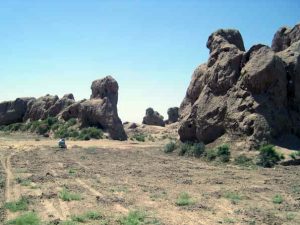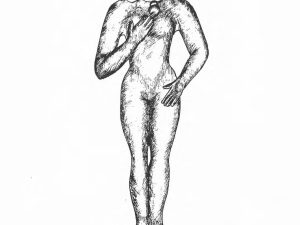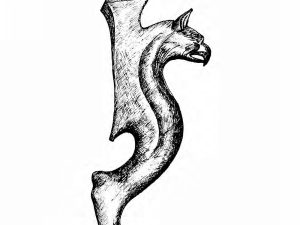Tuzandejanتوزندجان
Location: Northeastern Iran, the Province of Khorasan (Khorasan-e Razavi)
36°14’56.7″N 58°30’26.8″E
Qal’eh Kohney-e Tuzandejan is an archaeological site near a small village of that name situated about 25 km west of Nishapur in Khorasan.
Map
Historical Period
Parthian, Sasanian, Islamic
History and description
The archaeological site is reached by going 20 km from Nishapur toward Sabzevar, to the junction of the asphalt road and the railroad. Then after about 5 km to the south, the village of Tuzandejan can be seen. Two hundred meters north of the village is an old, ruined fortress that has been destroyed by bulldozers of farmers who leveled it down during ploughing and farming activities (fig. 1). Today, remains of the ruined fortress are in the form of a low mound with debris of mud-brick walls.
Archaeological Exploration
A brief survey was undertaken by Mahmoud Mousavi in 1986. The site has an archaeological sequence from the Parthian to the early Islamic periods. The surface of the site is covered with Sasanian potsherds and bricks, as well as ceramics of the 10th to 13th centuries. The fortress, possibly built in the 11th/12th century, has a square plan with four circular towers in mud-brick, of which two have survived.
Finds
Aside from scattered potsherds and fragmentary bricks, two bronze statuettes were found by peasants while farming there. The first is a statuette depicting the figure of a standing nude woman covering her right breast and putting her left hand below her navel (fig. 2). It measures 32 cm in height and 8 cm in diameter at its pedestal. It has a hat or crown with a necklace including an object similar to an amulet. The figure was probably a furniture support or leg (Mousavi, “Two bronze statuettes from Tuzandejan,” p. 122, fig. 2, pls. 3-4). Another important find is the statuette of a griffin, the back of which is attached to a support in the form of a furniture leg (fig. 3). It measures 29 cm in height and 7 cm in diameter at its pedestal. The piece is tapered and possibly served as the leg for a low piece furniture or throne (Mousavi, “Two bronze statuettes from Tuzandejan,” p. 128, fig. 5, pls. 5-6).
Bibliography
Mousavi, A., “Two Bronze Statuettes from Tuzandejan, Khorasan,” Bulletin of the Ancient Orient Museum, vol. 11, 1990, pp. 121-134
Author: Ali Mousavi, June 1st, 2021
Originally published: June 2, 2021
Last updated: September 19, 2024




































































































































